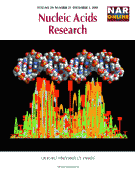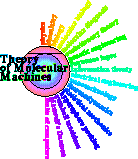
2001 December 1 issue of
Nucleic Acids Research
Flippers, Flappers and Flip-Flops in DNA Binding
Abstract of a talk by Thomas D. Schneider

2001 December 1 issue of Nucleic Acids Research |
Flippers, Flappers and Flip-Flops in DNA BindingAbstract of a talk by Thomas D. Schneider |

|
 The mathematics of information theory provides powerful tools for cracking
problems in molecular biology. For example, the packing of spheres in high
dimensional spaces is directly related to molecular states. More details
about this topic can be found at:
https://alum.mit.edu/www/toms/. In
this talk I will show how we used information theory to understand two kinds
of genetic control system.
The mathematics of information theory provides powerful tools for cracking
problems in molecular biology. For example, the packing of spheres in high
dimensional spaces is directly related to molecular states. More details
about this topic can be found at:
https://alum.mit.edu/www/toms/. In
this talk I will show how we used information theory to understand two kinds
of genetic control system.
Genetic control is often done in a simple way: a protein binds to a spot near the start of a gene and physically prevents the gene from being used (that is, it blocks the DNA from being transcribed into RNA). The amount of pattern in the DNA can be measured in bits of information, and this reveals that the protein shape molds to the surface of the DNA during evolution. DNA has major (ie wide) and minor (ie narrow) grooves and proteins can get more information from the major groove (2 bits) than they can from the minor groove (1 bit). This can be seen clearly using information theory.
In the first genetic system, a virus called P1 replicates its DNA in the intestinal bacterium Escherichia coli by using a control protein called RepA. Surprisingly, RepA violates the idea given above. When a theory appears to fail it can teach us new things. In this case RepA probably is flipping a base out of the DNA (swivelling half of a DNA ladder rung out of the ladder) in order to start the opening of DNA for DNA replication. Strong experimental evidence was found to support this hypothesis.
In the second genetic system, we discovered that the Fis protein (which controls all kinds of stuff in E. coli frequently uses pairs of sites 7 or 11 base pairs apart on DNA. Two overlapping Fis sites separated by 11 base pairs are found in the E. coli origin of chromosomal replication (the place where replication begins). We found that only one of the two overlapping Fis sites is bound by Fis at a time, so the structure is a molecular flip-flop. Since the two sites are precisely positioned between two DnaA sites, and these determine the orientation of the DnaB helicase, we suggest that the flip-flop directs alternative firing of replication complexes in opposite directions. Since they can implement Boolean logic, molecular flipflops could be used to build molecular computers. Both of these discoveries were made only because of the clarity that information theory provides.
References:
![]()

Schneider Lab
origin: 2001 2001 Dec 9
updated: 2001 2001 Dec 12
![]()